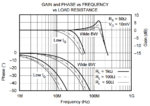slimbobaggins
Newbie level 6
I feel like I'm being stupid about this, but I need a sanity check.
In my attached schematic, my amplifier is driving a heliax cable approximately 1 mile in length, IF = 1 MHz, output power up to 20 dBm, must be linear within 0.1 dB. The heliax is connected on the other side to a 50 ohm load.
I'm planning to use a BUF634 to drive the output. It's unity gain, and the datasheet doesn't state the output impedance but I ASSume it's fairly low.
I need the 49.9 ohm series resistor on the output of the BUF634, to match the line, yes? Otherwise I'm subject to reflections across the cable.
I'm aware that doing this causes me to lose 6 dB of signal on the output and if it's not necessary then I'd rather not have to do it... I'm having a difficult time maintaining 0.1 dB output linearity at the top end of my signal range... the system would have to work a lot less hard if I had some of that 6 dB back.

In my attached schematic, my amplifier is driving a heliax cable approximately 1 mile in length, IF = 1 MHz, output power up to 20 dBm, must be linear within 0.1 dB. The heliax is connected on the other side to a 50 ohm load.
I'm planning to use a BUF634 to drive the output. It's unity gain, and the datasheet doesn't state the output impedance but I ASSume it's fairly low.
I need the 49.9 ohm series resistor on the output of the BUF634, to match the line, yes? Otherwise I'm subject to reflections across the cable.
I'm aware that doing this causes me to lose 6 dB of signal on the output and if it's not necessary then I'd rather not have to do it... I'm having a difficult time maintaining 0.1 dB output linearity at the top end of my signal range... the system would have to work a lot less hard if I had some of that 6 dB back.

